Microservices with Spring Boot : Service Discovery Using Eureka
In this article, we will implement service discovery for two microservices developed using Spring Boot that will synchronously communicate with each other using Spring's RestTemplate.

A microservice needs to know the location (IP address and port) of every service it communicates with. If we don’t employ a Service Discovery mechanism, service locations become coupled, leading to a system that’s difficult to maintain. We could wire the locations or inject them via configuration in a traditional application, but it isn’t recommended in a modern cloud-based application of this kind.
The Service Discovery mechanism helps us know where each instance is located. In this way, a Service Discovery component acts as a registry in which the addresses of all instances are tracked. The instances have dynamically assigned network paths. Consequently, if a client wants to make a request for a service, it must use a Service Discovery mechanism.
Let us set up the Eureka Discovery Server
Note: For this article, we will use maven.
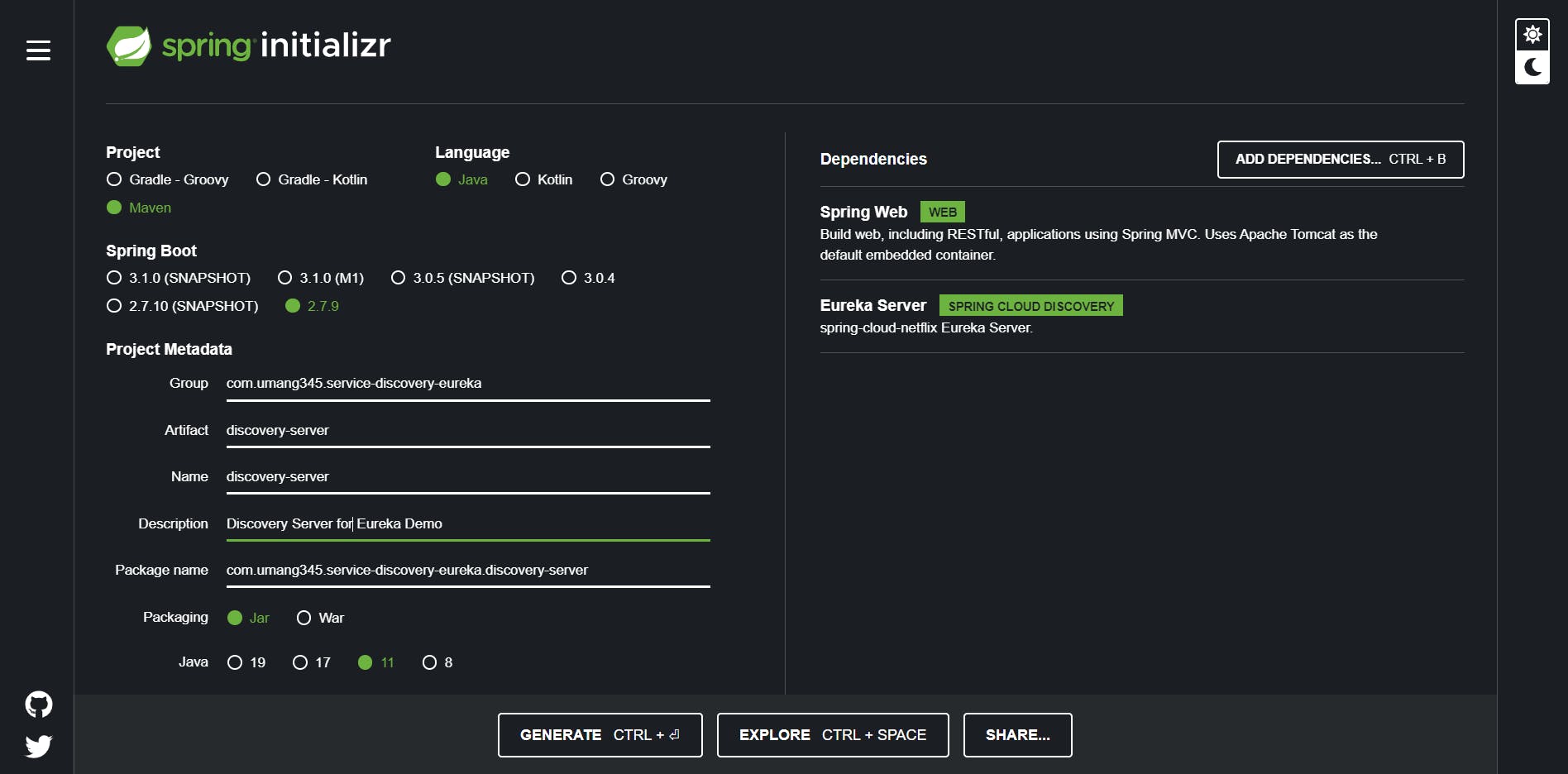
Add the following dependencies :
Spring Web
Eureka Server
For this article, we are using Spring Boot version 2.7.9 and Java 11.
Click on Generate and open the project in an IDE (IntelliJ, Eclipse, VSCode, etc)
Add the application.yml file
We will add the server port and eureka server configuration in the application.yml file.
discovery-server/resources/application.yml
eureka:
instance:
hostname: localhost
client:
register-with-eureka: false
fetch-registry: false
server:
port: 8761
Note: The properties
register-with-eurekaandfetch-registryis set to false because we don't want the discovery server itself to get registered as a client.
Add the @ EnableEurekaServer annotation
In the DiscoveryServerApplication.java class, add the annotation @ EnableEurekaServer.
discovery-server/DiscoveryServerApplication.java
import org.springframework.boot.SpringApplication;
import org.springframework.boot.autoconfigure.SpringBootApplication;
import org.springframework.cloud.netflix.eureka.server.EnableEurekaServer;
@SpringBootApplication
@EnableEurekaServer
public class DiscoveryServerApplication {
public static void main(String[] args) {
SpringApplication.run(DiscoveryServerApplication.class, args);
}
}
This completes our discovery server. Our discovery server will be up on port 8761.
Build the user service
Note: For this article, we will use maven.
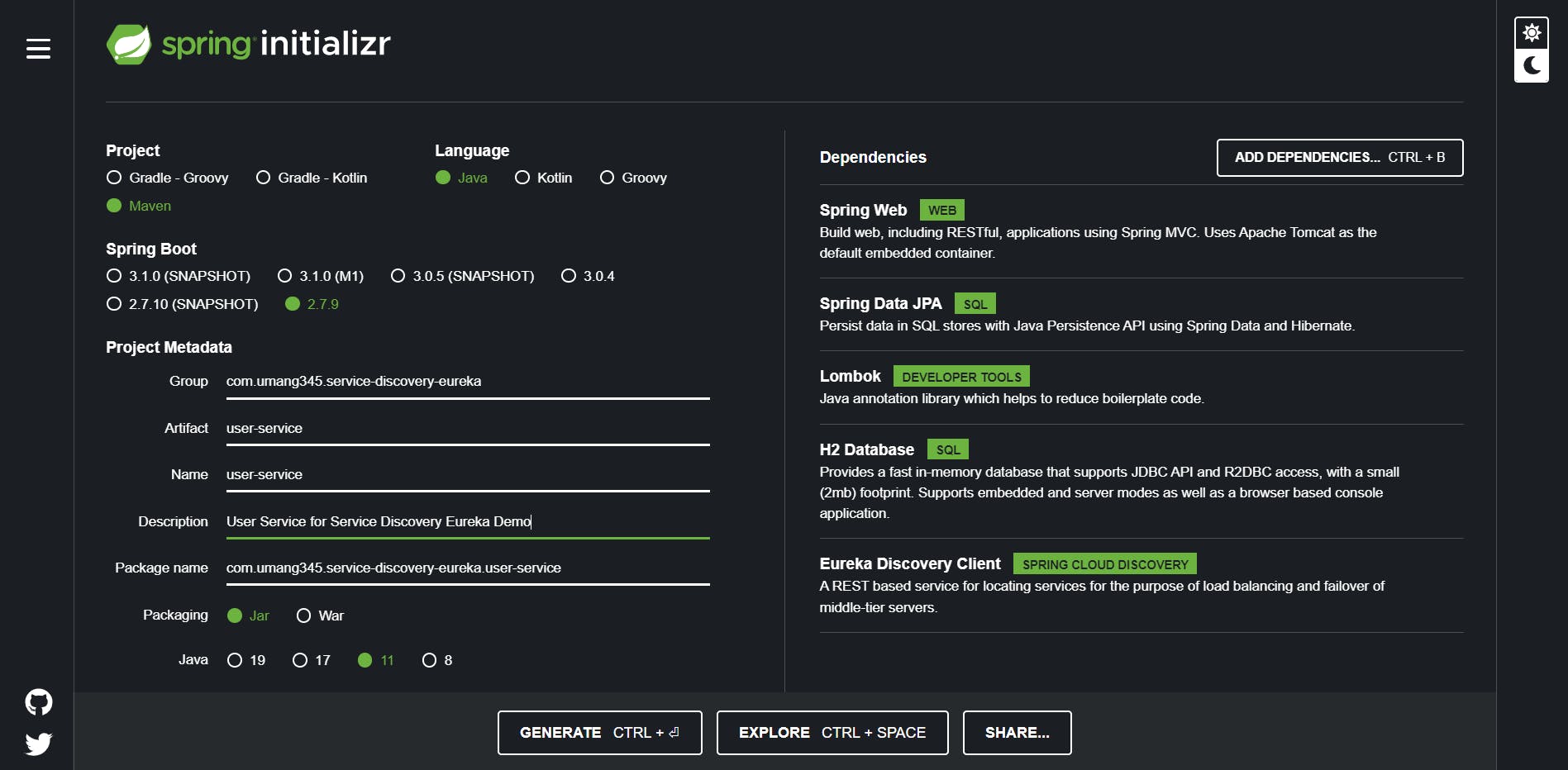
Add the following dependencies :
Spring Web
Lombok
Spring Data JPA
H2 Database
Eureka Discovery Client
For this article, we are using Spring Boot version 2.7.9 and Java 11.
Click on Generate and open the project in an IDE (IntelliJ, Eclipse, VSCode, etc)
Create a User Entity
Create an entities package and inside it create a User.java class
User.java
import lombok.*;
import javax.persistence.*;
@Entity
@Getter
@Setter
@ToString
@AllArgsConstructor
@NoArgsConstructor
@Builder
@Table(name = "users")
public class User
{
@Id
@GeneratedValue(strategy = GenerationType.AUTO)
long id;
String firstName;
String lastName;
String email;
}
Create a JPA Repository for User
Create a package named repositories and create an interface for the user JPA repository.
UserRepository.java
import com.umang345.userservicesyncresttemplate.entities.User;
import org.springframework.data.jpa.repository.JpaRepository;
import org.springframework.stereotype.Repository;
@Repository
public interface UserRepository extends JpaRepository<User, Long> {
}
Add database properties and eureka client configuration in the application.yml file
Add H2 Database properties, server port and eureka client configuration in the application.yml file
user-service/application.yml
eureka:
instance:
prefer-ip-address: true
client:
register-with-eureka: true
fetch-registry: true
service-url:
defaultZone: http://localhost:8761/eureka
server:
port: 8081
spring:
application:
name: USER-SERVICE
datasource:
url: "jdbc:h2:mem:testdb"
driverClassName: org.h2.Driver
username: sa
password: password
jpa:
database-platform: org.hibernate.dialect.H2Dialect
h2:
console:
enabled: true
path: /h2
Create custom exception
We will create a ResourceNotFoundException to deal with situations when the user that is requested is not present in the database.
We will create our exception classes in our exceptions package
user-service/ResourceNotFoundException.java
import org.springframework.http.HttpStatus;
import org.springframework.web.bind.annotation.ResponseStatus;
@ResponseStatus(value = HttpStatus.NOT_FOUND)
public class ResourceNotFoundException extends Exception
{
public ResourceNotFoundException(String message){
super(message);
}
public ResourceNotFoundException(){
super("The requested resource could not be found");
}
}
Create a custom error message
To handle the exception globally we will define a custom error message in our exceptions package.
user-service/ErrorMessage.java
import lombok.AllArgsConstructor;
import lombok.Builder;
import lombok.Getter;
import lombok.Setter;
@AllArgsConstructor
@Getter
@Setter
@Builder
public class ErrorMessage
{
private String message;
private String details;
}
Create a global exception handler
We will implement a global exception handler class that will handle our ResourceNotFoundException and also any generic exception.
user-service/GlobalExceptionHandler.java
import org.springframework.http.HttpStatus;
import org.springframework.http.ResponseEntity;
import org.springframework.web.bind.annotation.ControllerAdvice;
import org.springframework.web.bind.annotation.ExceptionHandler;
import org.springframework.web.context.request.WebRequest;
@ControllerAdvice
public class GlobalExceptionHandler
{
@ExceptionHandler(ResourceNotFoundException.class)
public ResponseEntity<?> resourceNotFoundExceptionHandler(ResourceNotFoundException ex, WebRequest request){
ErrorMessage errorMessage = ErrorMessage
.builder()
.message(ex.getMessage())
.details(request.getDescription(false))
.build();
return new ResponseEntity<>(errorMessage, HttpStatus.NOT_FOUND);
}
@ExceptionHandler(Exception.class)
public ResponseEntity<?> globalExceptionHandler(Exception ex, WebRequest request){
ErrorMessage errorMessage = ErrorMessage
.builder()
.message(ex.getMessage())
.details(request.getDescription(false))
.build();
return new ResponseEntity<>(errorMessage, HttpStatus.INTERNAL_SERVER_ERROR);
}
}
Define the methods in the UserService interface
We will create a service layer over the JPA layer. Create a service package and add a UserService interface.
user-service/UserService.java
import com.umang345.userservicesyncresttemplate.entities.User;
import org.springframework.stereotype.Service;
import java.util.List;
@Service
public interface UserService
{
User createUser(User newUser);
User getUserById(long userId);
User updateUser(User user, long userId);
List<User> getAllUser();
void deleteUser(long userId);
}
Implement the UserService interface
We will add an implementation for the UserService interface.
user-service/UserServiceImpl.java
import com.umang345.userservicesyncresttemplate.entities.User;
import com.umang345.userservicesyncresttemplate.exceptions.ResourceNotFoundException;
import com.umang345.userservicesyncresttemplate.repositories.UserRepository;
import org.springframework.beans.factory.annotation.Autowired;
import org.springframework.stereotype.Service;
import java.util.List;
@Service
public class UserServiceImpl implements UserService {
@Autowired
private UserRepository userRepository;
@Override
public User createUser(User newUser) {
User savedUser = userRepository.save(newUser);
return savedUser;
}
@Override
public User getUserById(long userId) {
User fetchedUser = null;
try {
fetchedUser = userRepository.findById(userId)
.orElseThrow(() -> new ResourceNotFoundException("User not found with id : "+userId));
} catch (ResourceNotFoundException e) {
e.printStackTrace();
}
return fetchedUser;
}
@Override
public User updateUser(User user, long userId) {
User currentUser = null;
try {
currentUser = userRepository.findById(userId)
.orElseThrow(() -> new ResourceNotFoundException("User not found with id : "+userId));
currentUser.setFirstName(user.getFirstName());
currentUser.setLastName(user.getLastName());
currentUser.setEmail(user.getEmail());
} catch (ResourceNotFoundException e) {
e.printStackTrace();
return null;
}
User updateUser = userRepository.save(currentUser);
return updateUser;
}
@Override
public List<User> getAllUser() {
List<User> users = userRepository.findAll();
return users;
}
@Override
public void deleteUser(long userId) {
User currentUser = null;
try {
currentUser = userRepository.findById(userId)
.orElseThrow(() -> new ResourceNotFoundException("User not found with id : "+userId));
} catch (ResourceNotFoundException e) {
e.printStackTrace();
}
userRepository.delete(currentUser);
}
}
Add the Controller for the User
We will implement a UserController that will expose the endpoints for the CRUD operations.
user-service/UserController.java
import com.umang345.userservicesyncresttemplate.entities.User;
import com.umang345.userservicesyncresttemplate.services.UserService;
import org.springframework.beans.factory.annotation.Autowired;
import org.springframework.http.HttpStatus;
import org.springframework.http.ResponseEntity;
import org.springframework.web.bind.annotation.*;
import java.util.HashMap;
import java.util.List;
import java.util.Map;
@RestController
@RequestMapping("/users")
public class UserController
{
@Autowired
private UserService userService;
@GetMapping("/{userId}")
public ResponseEntity<?> getUserById(@PathVariable Long userId)
{
User user = userService.getUserById(userId);
Map<String, Object> response = new HashMap<>();
if(user==null){
User nullUser = User.builder().id(0).firstName(null).lastName(null).email(null).build();
response.put("status", HttpStatus.NOT_FOUND.value());
response.put("data", nullUser);
return ResponseEntity.status(HttpStatus.OK).body(response);
}
response.put("status", HttpStatus.OK.value());
response.put("data", user);
return ResponseEntity.ok().body(response);
}
@GetMapping
public ResponseEntity<?> getAllUsers(){
List<User> users = userService.getAllUser();
Map<String, Object> response = new HashMap<>();
response.put("status", HttpStatus.OK.value());
response.put("data", users);
return ResponseEntity.ok().body(response);
}
@PostMapping
public ResponseEntity<?> createUser(@RequestBody User newUser) {
User createdUser = userService.createUser(newUser);
Map<String, Object> response = new HashMap<>();
response.put("status", HttpStatus.CREATED.value());
response.put("data", createdUser);
return ResponseEntity.ok().body(response);
}
@PutMapping("/{userId}")
public ResponseEntity<?> updateUser(@RequestBody User user, @PathVariable Long userId){
User updateUser = userService.updateUser(user,userId);
Map<String, Object> response = new HashMap<>();
if(updateUser==null){
User nullUser = User.builder().id(0).firstName(null).lastName(null).email(null).build();
response.put("status", HttpStatus.NOT_FOUND.value());
response.put("data", nullUser);
return ResponseEntity.status(HttpStatus.OK).body(response);
}
response.put("status", HttpStatus.OK.value());
response.put("data", updateUser);
return ResponseEntity.ok().body(response);
}
@DeleteMapping("/{userId}")
public ResponseEntity<?> deleteUser(@PathVariable Long userId)
{
userService.deleteUser(userId);
return ResponseEntity.ok().body("User deleted successfully with Id : "+userId);
}
}
pom.xml
The pom.xml for the user service must contain the following dependencies :
user-service/pom.xml
<dependencies>
<dependency>
<groupId>org.springframework.boot</groupId>
<artifactId>spring-boot-starter-data-jpa</artifactId>
</dependency>
<dependency>
<groupId>org.springframework.boot</groupId>
<artifactId>spring-boot-starter-web</artifactId>
</dependency>
<dependency>
<groupId>org.springframework.cloud</groupId>
<artifactId>spring-cloud-starter-netflix-eureka-server</artifactId>
</dependency>
<dependency>
<groupId>com.h2database</groupId>
<artifactId>h2</artifactId>
<scope>runtime</scope>
</dependency>
<dependency>
<groupId>org.projectlombok</groupId>
<artifactId>lombok</artifactId>
<optional>true</optional>
</dependency>
<dependency>
<groupId>org.springframework.boot</groupId>
<artifactId>spring-boot-starter-test</artifactId>
<scope>test</scope>
</dependency>
</dependencies>
<dependencyManagement>
<dependencies>
<dependency>
<groupId>org.springframework.cloud</groupId>
<artifactId>spring-cloud-dependencies</artifactId>
<version>${spring-cloud.version}</version>
<type>pom</type>
<scope>import</scope>
</dependency>
</dependencies>
</dependencyManagement>
<build>
<plugins>
<plugin>
<groupId>org.springframework.boot</groupId>
<artifactId>spring-boot-maven-plugin</artifactId>
<configuration>
<excludes>
<exclude>
<groupId>org.projectlombok</groupId>
<artifactId>lombok</artifactId>
</exclude>
</excludes>
</configuration>
</plugin>
</plugins>
</build>
Add the @ EnableEurekaClient annotation
Add the @ EnableEurekaClient annotation in the UserServiceApplication.java class.
import org.springframework.boot.SpringApplication;
import org.springframework.boot.autoconfigure.SpringBootApplication;
import org.springframework.cloud.netflix.eureka.EnableEurekaClient;
@SpringBootApplication
@EnableEurekaClient
public class UserServiceApplication {
public static void main(String[] args) {
SpringApplication.run(UserServiceApplication.class, args);
}
}
With this, we complete our user service.
Build the Runner Service
Now we will build the runner service that is directly called by the client.
Go to https://start.spring.io/

Add the following dependencies :
Spring Web
Lombok
Eureka Discovery Client
For this article, we are using Spring Boot version 2.7.9 and Java 11.
Click on Generate and open the project in an IDE (IntelliJ, Eclipse, VSCode, etc)
Create the User entity
We will create the same user entity for the runner class by adding the database properties.
runner-service/User.java
@Getter
@Setter
@ToString
@AllArgsConstructor
@NoArgsConstructor
@Builder
public class User
{
long id;
String firstName;
String lastName;
String email;
}
Add a Bean for the RestTemplate
We will create a separate configuration class and add a Bean for the RestTemplate there.
MyConfiguration.java
import org.springframework.context.annotation.Bean;
import org.springframework.context.annotation.Configuration;
import org.springframework.web.client.RestTemplate;
@Configuration
public class MyConfiguration
{
@Bean
@LoadBalanced
public RestTemplate getRestTemplate() {
return new RestTemplate();
}
}
Note: Make sure you add the @ LoadBalanced annotation to the RestTemplate Bean
Add eureka client configuration in the application.yml file
Add the server port and eureka client configuration in the application.yml file
user-service/application.yml
eureka:
instance:
prefer-ip-address: true
client:
register-with-eureka: true
fetch-registry: true
service-url:
defaultZone: http://localhost:8761/eureka
server:
port: 8080
spring:
application:
name: RUNNER-SERVICE
pom.xml
pom.xml of the runner service should contain the following dependencies.
<dependencies>
<dependency>
<groupId>org.springframework.boot</groupId>
<artifactId>spring-boot-starter-web</artifactId>
</dependency>
<dependency>
<groupId>org.springframework.cloud</groupId>
<artifactId>spring-cloud-starter-netflix-eureka-client</artifactId>
</dependency>
<dependency>
<groupId>org.projectlombok</groupId>
<artifactId>lombok</artifactId>
<optional>true</optional>
</dependency>
<dependency>
<groupId>org.springframework.boot</groupId>
<artifactId>spring-boot-starter-test</artifactId>
<scope>test</scope>
</dependency>
</dependencies>
<dependencyManagement>
<dependencies>
<dependency>
<groupId>org.springframework.cloud</groupId>
<artifactId>spring-cloud-dependencies</artifactId>
<version>${spring-cloud.version}</version>
<type>pom</type>
<scope>import</scope>
</dependency>
</dependencies>
</dependencyManagement>
<build>
<plugins>
<plugin>
<groupId>org.springframework.boot</groupId>
<artifactId>spring-boot-maven-plugin</artifactId>
<configuration>
<excludes>
<exclude>
<groupId>org.projectlombok</groupId>
<artifactId>lombok</artifactId>
</exclude>
</excludes>
</configuration>
</plugin>
</plugins>
</build>
Add the Controller for the Runner Service
We will add the RunnerController that shall contain the endpoints for the client to call and the methods shall make a synchronous call to the user service to get the data.
RunnerController.java
import com.umang345.runnersimulationservicesyncresttemplate.entities.User;
import org.springframework.beans.factory.annotation.Autowired;
import org.springframework.http.*;
import org.springframework.web.bind.annotation.*;
import org.springframework.web.client.RestTemplate;
import java.util.Map;
@RestController
@RequestMapping("/simulate/users")
public class RunnerController
{
@Autowired
private RestTemplate restTemplate;
@GetMapping
public ResponseEntity<?> getAllUsers(){
ResponseEntity<Map> response = restTemplate.exchange("http://localhost:8081/users",HttpMethod.GET,new HttpEntity<>(new HttpHeaders()),Map.class);
return ResponseEntity.ok().body(response.getBody().get("data"));
}
@GetMapping("/{userId}")
public ResponseEntity<?> getUserById(@PathVariable Long userId) {
ResponseEntity<Map> response = null;
try {
response = restTemplate.exchange("http://localhost:8081/users/"+userId,HttpMethod.GET,new HttpEntity<Map>(new HttpHeaders()), Map.class);
Map<String,Object> res = response.getBody();
if((Integer)res.get("status") != HttpStatus.OK.value())
{
throw new Exception("User not found with Id : "+userId);
}
return ResponseEntity.status(HttpStatus.OK).body(res.get("data"));
}
catch (Exception e){
return ResponseEntity.status(HttpStatus.NOT_FOUND).body(e.getMessage());
}
}
@PostMapping
public ResponseEntity<?> createUser(@RequestBody User newUser){
ResponseEntity<Map> response = null;
try {
response = restTemplate.exchange("http://localhost:8081/users",HttpMethod.POST,new HttpEntity<>(newUser),Map.class);
Map<String,Object> res = response.getBody();
if((Integer)res.get("status") != HttpStatus.CREATED.value())
{
throw new Exception("Error while creating user");
}
return ResponseEntity.status(HttpStatus.OK).body(res.get("data"));
}catch (Exception e) {
return ResponseEntity.status(HttpStatus.INTERNAL_SERVER_ERROR).body(e.getMessage());
}
}
@PutMapping("/{userId}")
public ResponseEntity<?> updateUser(@RequestBody User user, @PathVariable Long userId){
ResponseEntity<Map> response = null;
try{
response = restTemplate.exchange("http://localhost:8081/users/"+userId,HttpMethod.PUT,new HttpEntity<>(user),Map.class);
Map<String,Object> res = response.getBody();
if((Integer)res.get("status") != HttpStatus.OK.value())
{
throw new Exception("User not found with Id : "+userId);
}
return ResponseEntity.status(HttpStatus.OK).body(res.get("data"));
}catch (Exception e){
return ResponseEntity.status(HttpStatus.NOT_FOUND).body(e.getMessage());
}
}
@DeleteMapping("/{userId}")
public ResponseEntity<?> deleteUser(@PathVariable Long userId)
{
try {
ResponseEntity<String> response = restTemplate.exchange("http://localhost:8081/users/"+userId, HttpMethod.DELETE, new HttpEntity<User>(new HttpHeaders()), String.class);
return ResponseEntity.status(HttpStatus.OK).body("User deleted successfully with id : "+userId);
}catch (Exception e) {
return ResponseEntity.status(HttpStatus.NOT_FOUND).body("User not found with Id : "+userId);
}
}
}
In this case, the IP address and port of USER-SERVICE are hard-coded, we would replace it with the name of the USER SERVICE which would then dynamically be mapped from the eureka server.
RunnerController.java
import com.umang345.servicediscoveryeureka.runnerservice.entities.User;
import org.springframework.beans.factory.annotation.Autowired;
import org.springframework.http.*;
import org.springframework.web.bind.annotation.*;
import org.springframework.web.client.RestTemplate;
import java.util.Map;
@RestController
@RequestMapping("/simulate/users")
public class RunnerController
{
@Autowired
private RestTemplate restTemplate;
@GetMapping
public ResponseEntity<?> getAllUsers(){
ResponseEntity<Map> response = restTemplate.exchange("http://USER-SERVICE/users",HttpMethod.GET,new HttpEntity<>(new HttpHeaders()),Map.class);
return ResponseEntity.ok().body(response.getBody().get("data"));
}
@GetMapping("/{userId}")
public ResponseEntity<?> getUserById(@PathVariable Long userId) {
ResponseEntity<Map> response = null;
try {
response = restTemplate.exchange("http://USER-SERVICE/users/"+userId,HttpMethod.GET,new HttpEntity<Map>(new HttpHeaders()), Map.class);
Map<String,Object> res = response.getBody();
if((Integer)res.get("status") != HttpStatus.OK.value())
{
throw new Exception("User not found with Id : "+userId);
}
return ResponseEntity.status(HttpStatus.OK).body(res.get("data"));
}
catch (Exception e){
return ResponseEntity.status(HttpStatus.NOT_FOUND).body(e.getMessage());
}
}
@PostMapping
public ResponseEntity<?> createUser(@RequestBody User newUser){
ResponseEntity<Map> response = null;
try {
response = restTemplate.exchange("http://USER-SERVICE/users",HttpMethod.POST,new HttpEntity<>(newUser),Map.class);
Map<String,Object> res = response.getBody();
if((Integer)res.get("status") != HttpStatus.CREATED.value())
{
throw new Exception("Error while creating user");
}
return ResponseEntity.status(HttpStatus.OK).body(res.get("data"));
}catch (Exception e) {
return ResponseEntity.status(HttpStatus.INTERNAL_SERVER_ERROR).body(e.getMessage());
}
}
@PutMapping("/{userId}")
public ResponseEntity<?> updateUser(@RequestBody User user, @PathVariable Long userId){
ResponseEntity<Map> response = null;
try{
response = restTemplate.exchange("http://USER-SERVICE/users/"+userId,HttpMethod.PUT,new HttpEntity<>(user),Map.class);
Map<String,Object> res = response.getBody();
if((Integer)res.get("status") != HttpStatus.OK.value())
{
throw new Exception("User not found with Id : "+userId);
}
return ResponseEntity.status(HttpStatus.OK).body(res.get("data"));
}catch (Exception e){
return ResponseEntity.status(HttpStatus.NOT_FOUND).body(e.getMessage());
}
}
@DeleteMapping("/{userId}")
public ResponseEntity<?> deleteUser(@PathVariable Long userId)
{
try {
ResponseEntity<String> response = restTemplate.exchange("http://USER-SERVICE/users/"+userId, HttpMethod.DELETE, new HttpEntity<User>(new HttpHeaders()), String.class);
return ResponseEntity.status(HttpStatus.OK).body("User deleted successfully with id : "+userId);
}catch (Exception e) {
return ResponseEntity.status(HttpStatus.NOT_FOUND).body("User not found with Id : "+userId);
}
}
}
Add the @ EnableEurekaClient annotation
Add the @ EnableEurekaClient annotation in the RunnerServiceApplication.java class.
import org.springframework.boot.SpringApplication;
import org.springframework.boot.autoconfigure.SpringBootApplication;
import org.springframework.cloud.netflix.eureka.EnableEurekaClient;
@SpringBootApplication
@EnableEurekaClient
public class RunnerServiceApplication {
public static void main(String[] args) {
SpringApplication.run(RunnerServiceApplication.class, args);
}
}
This completes our runner service.
We are using Postman for testing our services.
POST
We will create two users
{
"firstName" : "Umang",
"lastName" : "Agarwal",
"email" : "ua@test.com"
},
{
"firstName" : "John",
"lastName" : "Doe",
"email" : "jd@test.com"
}
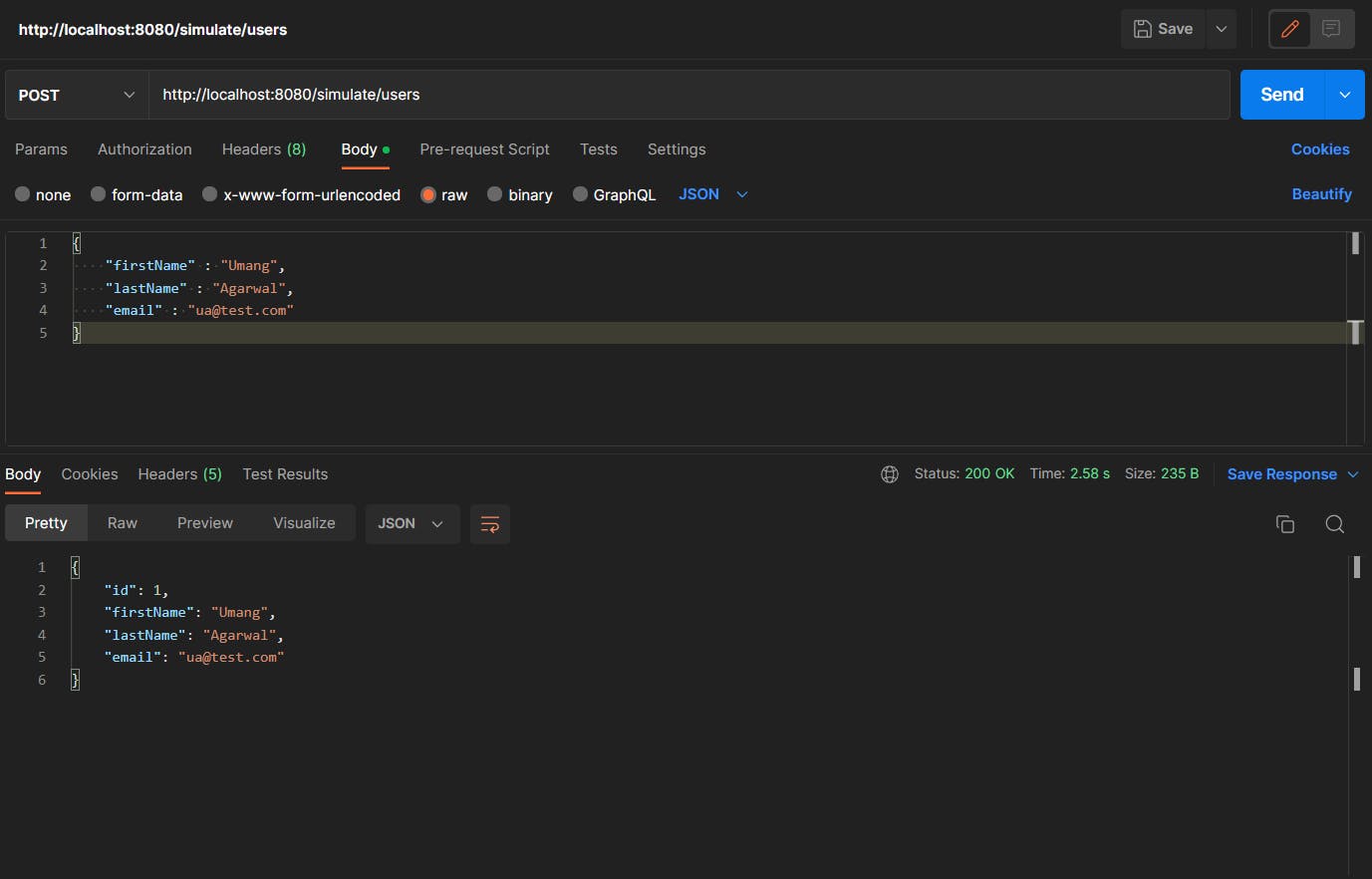
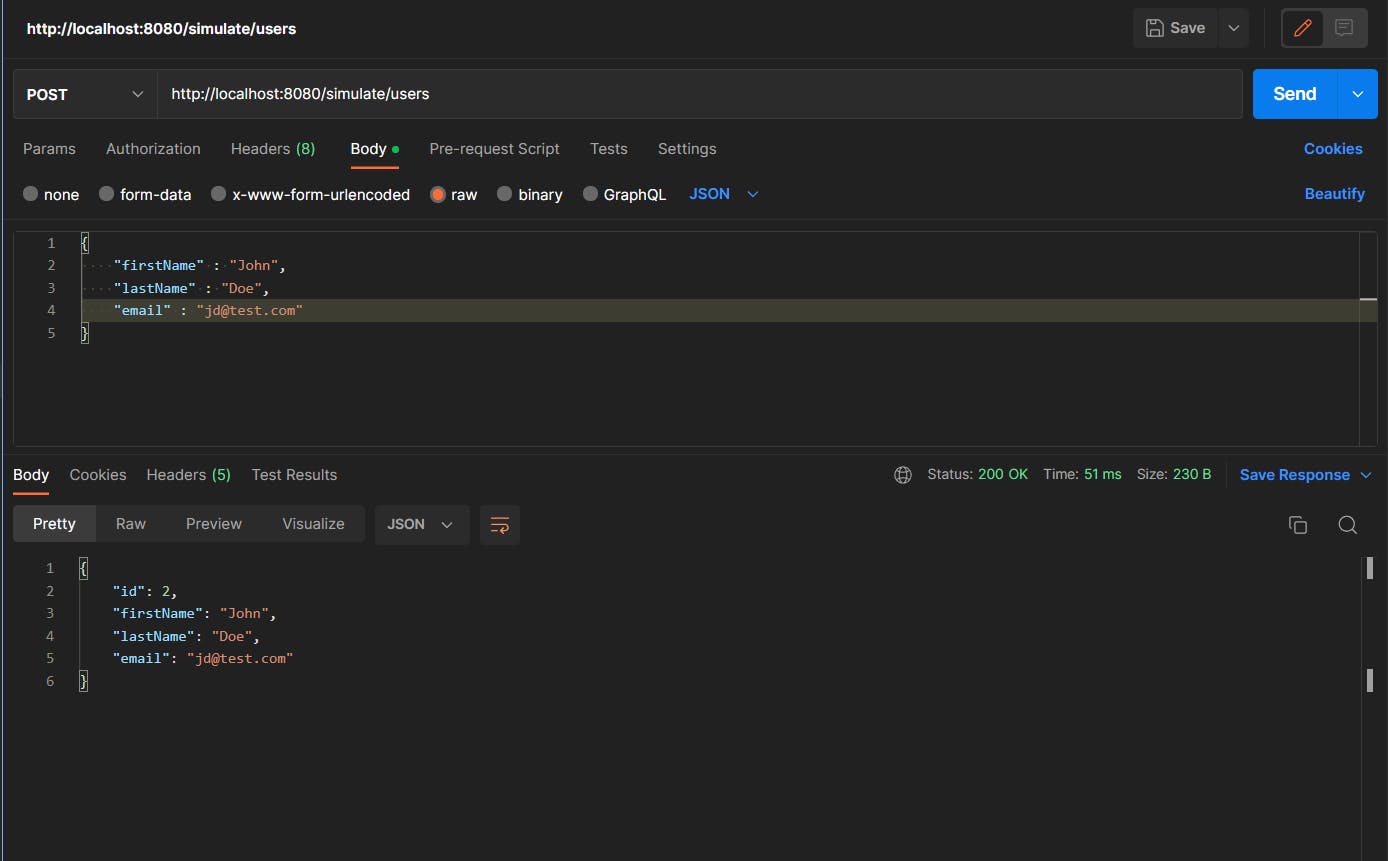
GET ALL
Let's fetch all the users.
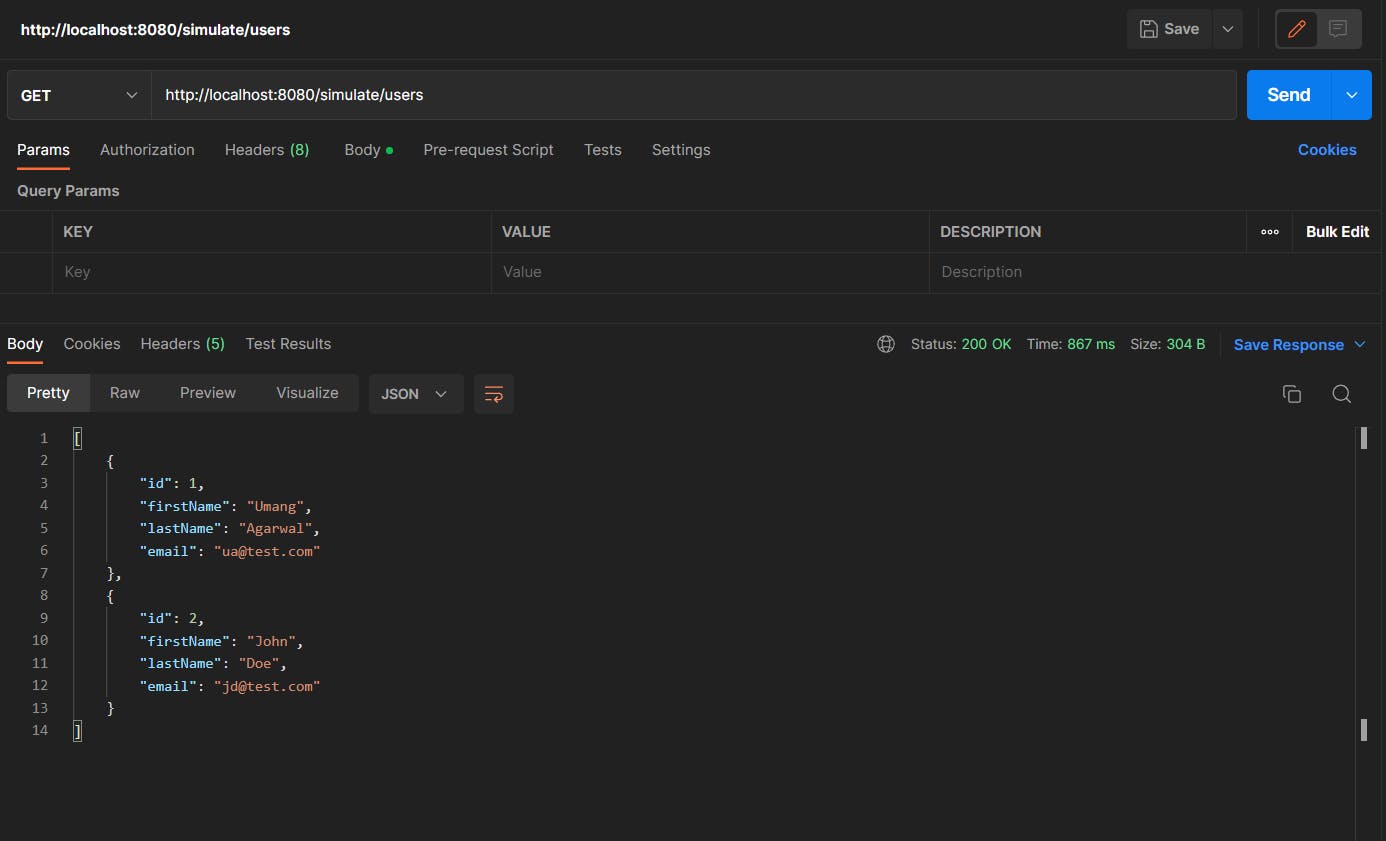
Get User By Id
Let's get the user with Id 2

PUT
Let's update the user with id 1
{
"id": 1,
"firstName" : "Umang",
"lastName" : "Agarwal",
"email" : "ua2@gmail.com"
}
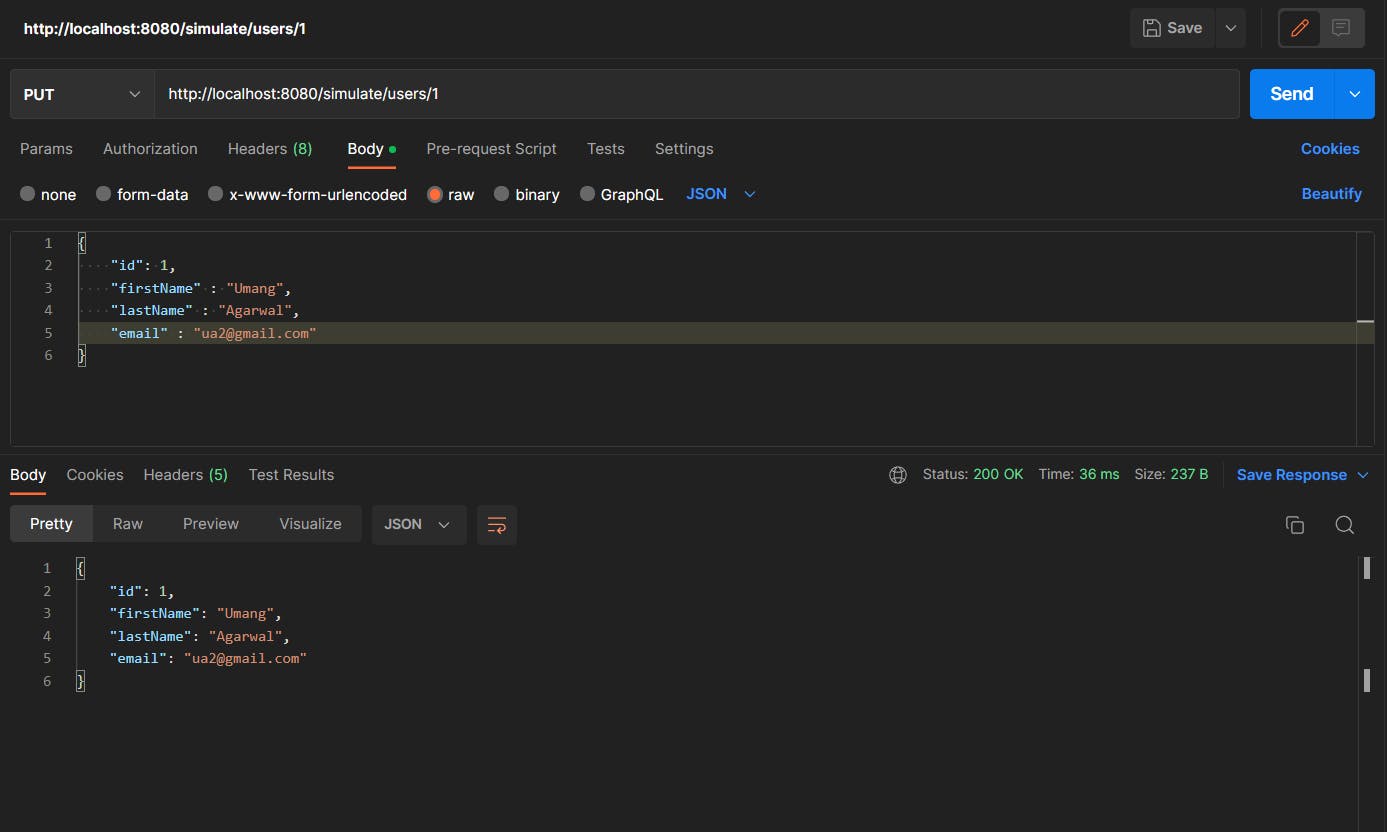
Delete
Let's delete the user with id 2

We have tested all our endpoints here.
Find the source code of the project on GitHub.
Do star the repository to access the source code of all the articles.
I hope you found the article useful.
Let's connect :
Happy Coding :)
